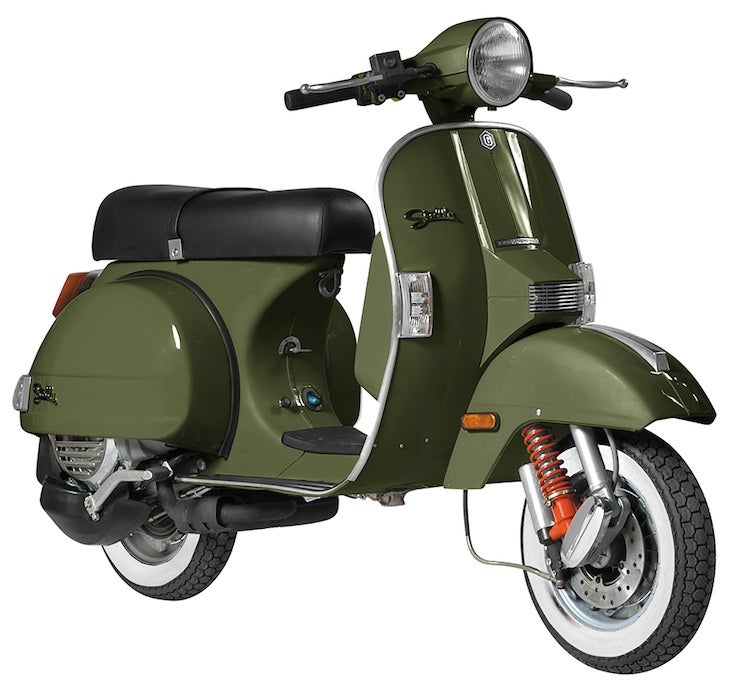 by "bhtooefr" (bhtooefr)
by "bhtooefr" (bhtooefr)
Published 11/10/2017 at 07:46
 by "bhtooefr" (bhtooefr)
by "bhtooefr" (bhtooefr)
Published 11/10/2017 at 07:46
Tags: vespa
; electric vehicles
; 2wheelsgood
; scooters
; piaggio
STARS: 1

This definitely doesnít have anything to do with
a certain announcement
of an electric scooter made by a certain large scooter/motorcycle manufacturing conglomerate.
!!! UNKNOWN CONTENT TYPE !!!
So, a Genuine Stella has 2.1 gallons of fuel capacity, per Motor Scooter Guide . Thatís just shy of 8 liters. The fuel tank on a classic Vespa or a clone thereof such as the Stella (except for the automatic Stella, actually) is mounted directly below the seat, very easily accessible.
Decently high power hub motors in the correct size for a later classic Vespa or a clone, 10", are available - this one claims to be 6 kW rated power (they have test results showing it going as high as 8 kW output power), which is just about the right amount of power, too. Iím sure a major manufacturer would have the resources to find something higher quality than that, too, maybe even with the right bolt pattern so you could maintain the spare tireís usefulness. Or, donít, and put a saddlebag where the spare tire was (you could put the 12 volt battery, which normally resides inside the spare tire well, where the oil tank used to be, or donít even bother with a 12 volt battery).
Panasonic claims 676 Wh per liter for the NCR18650B, which is actually one of their older cells. Even if your cell packing assumes square instead of round cells, youíre looking at 532 Wh per liter. So, by my calculations (looks like Panasonicís volumetric density calculations were based on 3.3 Ah/cell), thatís 4.2 kWh that would fit into a 2.1 gallon hole. Even if you adjust to aim for 72 V pack nominal voltage (meaning a 20S layout), youíre looking at 340 cells fitting there, which means 4.0 kWh. And, you wouldnít really need that much battery, so you could just make the pack lighter (I mean, 340 cells is basically 16.5 kg, not counting the packís own weight, so that is too heavy for regular swapping IMO, you want to stay below 15 kg for the whole pack). If you did put 4 kWh in there, though, Iím sure youíd have well over 100 km range.
Oh, and that pack would be mounted directly below the seat, very easily accessible , meaning battery swap becomes trivial.
Oh, and you even get to put a saddlebag where the engine used to be, increasing storage space over the ICE model.
Again, this thought definitely has nothing to do with the Vespa Elettrica and its lame specs and lack of battery swapping. No sir, nothing at all.
 "TheTurbochargedSquirrel" (thatsquirrel)
"TheTurbochargedSquirrel" (thatsquirrel)
11/10/2017 at 10:12, STARS: 0
With high voltage systems you add a bunch of complexity and cost to be able to charge the pack external to the vehicle. When the pack is in the vehicle you can have the onboard controls system monitor the battery monitoring system and control the isolation relays and charge into the pack with the external charger just being a simple DC or AC supply. If you want to charge with the pack outside the vehicle you now need to add control and monitoring hardware into the charger which increases the cost of the system.
They are engineering to a cost. Not many people are going to ride a scooter 100+ km at a time so why introduce the cost of more cells (and the increased complexity of the monitoring circuitry for those cells) when you donít need to.
 "bhtooefr" (bhtooefr)
"bhtooefr" (bhtooefr)
11/10/2017 at 10:24, STARS: 0
Battery swapping is something that I feel is a prerequisite for a scooter spending its time in urban areas - an electric scooter that you canít charge, or have to wait hours away from home to charge, is useless. Once youíre in suburban areas, overnight charging in a garage becomes much easier, and not supporting offboard charging makes more sense.
You could do what GenZe does, and put the charging hardware in the pack (their pack actually just takes a PC power cord to charge), although that adds quite a bit of weight to the pack, severely limiting how much battery capacity can be in the pack.
Or, you could do what Zero does for the FX/FXS - charging hardware onboard the bike, with an optional offboard charger for those that want it.
All of that said, most of whatís needed to handle charging is unique to charging, AFAIK - the BMS is going to be in the pack no matter what, not on the bike, so then itís just a matter of the charger communicating with the BMS directly, rather than through a master computer.
Also, I donít actually think that the 100 km range is bad, just pointing out that a manufacturer could beat it if they wanted to.
 "benjrblant" (benjblant)
"benjrblant" (benjblant)
11/10/2017 at 11:00, STARS: 1
Sidenote: Though the Stella is ďinspired byĒ (re: knockoff) of some older Vespas, I like the look of the Stella better than any current Vespa offerings.
 "bhtooefr" (bhtooefr)
"bhtooefr" (bhtooefr)
11/10/2017 at 11:16, STARS: 0
Although, the interesting thing is that the Bajaj Chetak and LML NV/Star/Genuine Stella arenít actually knockoffs per se - both were actually licensed clones for the Indian market.